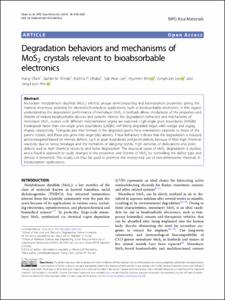Degradation behaviors and mechanisms of MoS2 crystals relevant to bioabsorbable electronics
- Title
- Degradation behaviors and mechanisms of MoS2 crystals relevant to bioabsorbable electronics
- Author(s)
- Chen, Xiang ; Shinde, Sachin M. ; Dhakal, Krishna P. ; Lee, Suk Woo ; Kim, Hyunmin ; Lee, Zong Hoon ; Ahn, Jong Hyun
- Issued Date
- 2018-08
- Citation
- NPG Asia Materials, v.10, no.8, pp.810 - 820
- Type
- Article
- Keywords
- MONOLAYER MOLYBDENUM-DISULFIDE ; TRANSITION-METAL DICHALCOGENIDES ; GRAIN-BOUNDARIES ; 2-DIMENSIONAL NANOMATERIALS ; ATOMIC DEFECTS ; LAYER MOS2 ; DEPOSITION ; GRAPHENE ; PLASMA ; GROWTH
- ISSN
- 1884-4049
- Abstract
- Monolayer molybdenum disulfide (MoS2) exhibits unique semiconducting and bioresorption properties, giving this material enormous potential for electronic/biomedical applications, such as bioabsorbable electronics. In this regard, understanding the degradation performance of monolayer MoS2 in biofluids allows modulation of the properties and lifetime of related bioabsorbable devices and systems. Herein, the degradation behaviors and mechanisms of monolayer MoS2 crystals with different misorientation angles are explored. High-angle grain boundaries (HAGBs) biodegrade faster than low-angle grain boundaries (LAGBs), exhibiting degraded edges with wedge and zigzag shapes, respectively. Triangular pits that formed in the degraded grains have orientations opposite to those of the parent crystals, and these pits grow into larger pits laterally. These behaviors indicate that the degradation is induced and propagated based on intrinsic defects, such as grain boundaries and point defects, because of their high chemical reactivity due to lattice breakage and the formation of dangling bonds. High densities of dislocations and point defects lead to high chemical reactivity and faster degradation. The structural cause of MoS2 degradation is studied, and a feasible approach to study changes in the properties and lifetime of MoS2 by controlling the defect type and density is presented. The results can thus be used to promote the widespread use of two-dimensional materials in bioabsorption applications. © 2018, The Author(s).
- Publisher
- Nature Publishing Group
- Related Researcher
-
-
Kim, Hyunmin 바이오메디컬연구부
- Research Interests Nonlinear optics; Femtosecond ultrafast carrier dynamics; Super resolution microscopy; Optical soliton transport; Biological imaging
-
- Files in This Item:
-
 기타 데이터 / 2.81 MB / Adobe PDF
download
기타 데이터 / 2.81 MB / Adobe PDF
download
- Appears in Collections:
- Division of Biotechnology 1. Journal Articles



